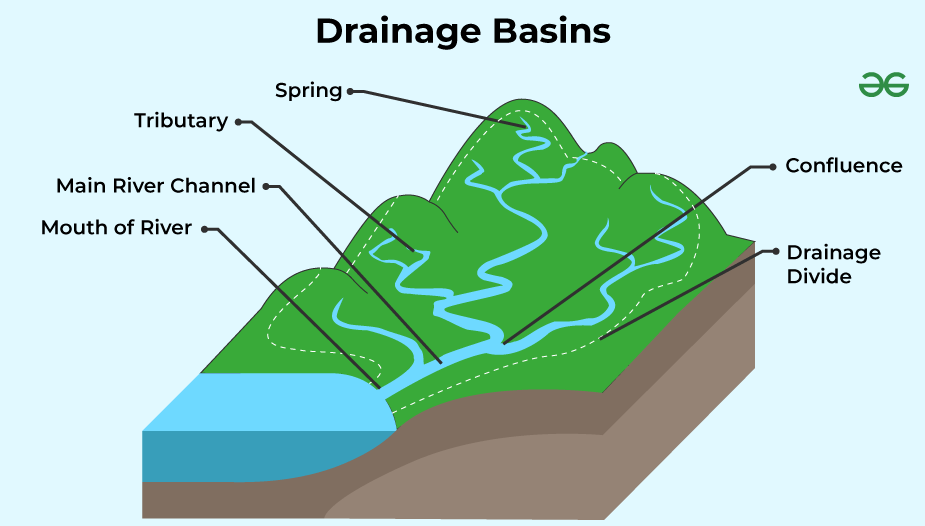Define the term Drainage and Drainage Basin
Last Updated :
14 Jul, 2023
Drainage, or the removal of surface water, is the process by which water filters downward from the top soil layers to bring down layers. The right kind of waste is important because not all plants prefer clammy conditions. In nature, some minerals, like sand, facilitate rapid seepage while heavier minerals, like dirt, can contain waste. Seepage for the holder or pruned plants is controlled by openings in the pot’s lower portion.
Unlucky seepage is frequently observed in areas where, after a rainstorm, water will be in the general pool. Manure or sand can be added to reduce seepage. Garden soil is designed with perlite or vermiculite expansion for satisfactory water leakage. Some plants are said to prefer “wet feet,” which means they can withstand prolonged periods of damp weather. Rain gardens serve as an example of nurseries that can withstand unfavorable waste. Conversely, succulents thrive in even drier environments and soils, so they need a lighter, better-depleted medium like sand. To move moisture away from the plant’s foundations in situations where appropriate waste cannot be removed using conventional methods, folded channeling known as tiling may be introduced beneath the developing surface.
Drainage Basin
A drainage basin refers to the area which is drained by a certain river and its tributaries. The drainage basin is also known as a catchment area or watershed area, from where the precipitation flows to a single stream of water. A drainage basin provides for a limited surface area within which the physical processes pertinent to the general form of water hydrology are considered.

Drainage Basins
Benefits of Drainage
The fundamental benefit of drainage frameworks is their ability to help prevent soil disintegration, one of the main causes of flooding in many homes. If you don’t have a patio channel set up, you may need to maintain it constantly, which could mean the difference between a luxurious outdoor living space and a demolished building. Remember that you need to be completely aware of what seepage frameworks do and how they work in order to understand how they manage the nursery humidity. You may need to water your plants and trees more frequently and with additional synthetic compounds if you don’t have a proper understanding of the water and seepage aids that they require.
Sorts of Drainage
Home businesses frequently fail because of regrettable water waste. Either water collects around the house, or the ground next to the business becomes soggy. Mortgage holders should definitely further develop waste around their homes by using a seepage framework because these problems could ultimately result in severe establishment damage.
The two main types of waste framework options are French channels and surface depletes. Frameworks for surface seepage include a few PVC funneling-related ground-level region depletes. When it rains, water flows into the funneling, down the channels, and is directed away from the house. PVC funneling with holes that are used in French channels is inserted into a deep channel and covered with rock. Since it collects the water and transports it to a different location, this channel prevents groundwater from penetrating beneath the house.
Drain Basin
A drain basin is a location where rainwater empties into a waterway. Water that evaporates from the oceans and other waterways and returns to the water supply through precipitation is part of the hydrologic cycle. Waste bowls use a variety of techniques to return precipitation-generated water to streams, lakes, and other bodies of water. The fundamental geologic features, which govern how water flows, have an impact on their temperament.
The land, as well as the various overground and underground water channels that pass through it, are contained within the drainage basin. A seepage bowl is ranked according to how the surrounding area region receives its water diverts. A waste bowl’s contribution to the water supply is the outcome. Therefore, what happens in a wastebasket is important for managing water resources. Toxins, such as dregs and horticultural overflow, may be carried by water information sources as they channel toward their goal. Flooding in a waste bowl can also result from an excess of water information and activities like deforestation. Many release bowl includes that are essential to the hydrologist can be evaluated as far as length, length squared, and length cubed. Models are height, stream length, bowl border, seepage region, and volume.
Function of Drain Basin
An area of land known as a seepage bowl is where rain or snow melts into liquid form and drains downhill into a waterway like a stream, lake, wetland, or sea. The land surface from which the water channels into those channels, as well as the streams and waterways that carry the water, are all included in the waste bowl. A characteristic seepage bowl is one in which the power source point is a characteristic happening highlight and is used as the basis for climate division waste bowl planning. These outlet focuses occur at the confluences of streams, where streams exit into waterbodies, and in impoundments.
Related Links
- Drainage System of India
- Largest drainage system in India
- Water Divide
Frequently Asked Questions
Q 1. What is drainage and drainage basin?
Answer-
Drainage refers to the area of river system and drainage basin refers to the river basin that is drained by a single river system.
Q 2. What is called drainage?
Answer-
Drainage refers to the process of removal of water either from surface of ground or rootzone, is known as drainage.
Q 3. What is a drainage system?
Answer-
Drainage system refers to the arrangement for moving liquids away from where they are not required for the disposal in an appropriate location.
Like Article
Suggest improvement
Share your thoughts in the comments
Please Login to comment...